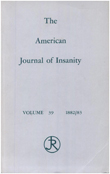Decline of U.S. medical student career choice of psychiatry and what to do about it
Abstract
OBJECTIVE: In 1994, only 3.2% of U.S. medical school graduates chose psychiatry, the lowest proportion since 1929. Success in recruiting such graduates is necessary to maintain adequate numbers of psychiatrists. The authors' goal was to gain an understanding of the determinants of specialty selection to ensure adequate recruitment. METHOD: They reviewed all recruitment-related English-language publications since 1959: 173 papers, 17 reports, and 10 books. RESULTS: They found that recruitment has been cyclical, with success from 1940 to 1969 and from 1985 to 1988, decline from 1970 to 1984 and from 1989 to 1994, and a possible small upswing in 1995. The 1940-1969 success began with 1) public recognition of a dramatic shortage of psychiatrists to serve in the military and treat casualties and 2) the fervor of the community mental health movement, which promised to prevent mental illness; massive resources were provided for psychiatry during this period. The declines were associated with 1) the failure of the community mental health movement to fulfill its promise, 2) psychiatry's becoming more biologically oriented and medically conventional, and 3) the effects of managed care and increased competition for patients. The psychiatry departments that have high recruitment rates are in public-supported schools, particularly in the South, or give considerable priority and resources for medical student psychiatric education. CONCLUSIONS: A study of the psychiatric workforce is needed to ascertain whether there is a surplus or a shortage of psychiatrists. Regardless, to ensure adequate recruitment, medical institutions and departments of psychiatry must commit resources for student education in psychiatry.
Access content
To read the fulltext, please use one of the options below to sign in or purchase access.- Personal login
- Institutional Login
- Sign in via OpenAthens
- Register for access
-
Please login/register if you wish to pair your device and check access availability.
Not a subscriber?
PsychiatryOnline subscription options offer access to the DSM-5 library, books, journals, CME, and patient resources. This all-in-one virtual library provides psychiatrists and mental health professionals with key resources for diagnosis, treatment, research, and professional development.
Need more help? PsychiatryOnline Customer Service may be reached by emailing [email protected] or by calling 800-368-5777 (in the U.S.) or 703-907-7322 (outside the U.S.).



